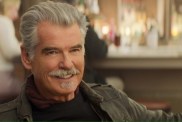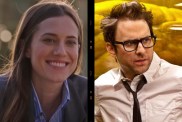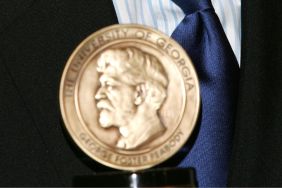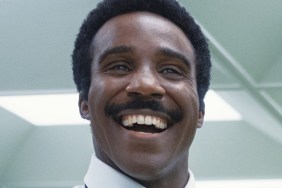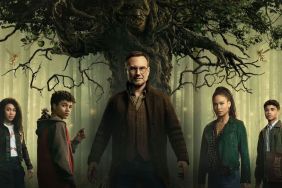
SHOCK rises to the defense of the blackly comic 1973 shocker THE WEREWOLF OF WASHINGTON.
Opening with a foreboding image of a full moon rising and accompanied by Dean Stockwells creepy voice, THE WEREWOLF OF WASHINGTON is a smart little film that parallels the cut throat ruthlessness of presidential candidacy with newfound social freedoms found in lycanthropy. Dean Stockwell stars as Jack Whittier, a reporter who is sent to Hungary after it is discovered that he was having an affair with the presidents daughter. The first time we see him, he is staring at a cane reminiscent of the silver wolf-headed one that was given to Lawrence Talbot by Gwen Conliffe in THE WOLF MAN (1941) to which this politically bent satire owes a lot to. The film has a dreamlike quality to it, with its slight use of fishbowl lenses, bizarre editing choices, cartoon-like compositions and frenzied performances from the likes of Stockwell and company, and for the most part the film is enjoyable. It does seem to run smoothly without any narrative hiccups, but unfortunately, to the date of this article, there is no real cleaned up print of the film which makes the viewing experience slightly stressful in that in the existing editions available for purchase (including the print that aired as part of Elviras Movie Macabre) are plagued by oppressive darkness and an unclear presentation.
Make-up artist Bob OBradovichs werewolf design is simple and similar to many of the male werewolves to populate the screen (both big and small) during the seventies and producer Nina Schulman was interested in giving the film a deep rooted political agenda that writer/director Milton Moses Ginsberg manages to carefully weave into the narrative mix. The opening in the old country is hurried along because we know the story a civilised westerner is going to be bitten by a werewolf and come back to the real world to unleash his bloody terror. Therefore, director Ginsberg gets this established in a fact-of-the-matter style that ends abruptly. Much like Bela Lugosis original werewolf being played by a real life dog, here there is much the same, with Stockwell beating the beast to death while sporting a massive bite on his chest. He then looks down at what was once the dead beast and sees that it has changed into a sinister gypsy.

Stockwells Jack is tormented from the get-go and siding along with his journey from already neurotic journalist to even more frazzled werewolf press secretary to the president (yes, the president forgives his indiscretions with his daughter and hires him as his right hand man because hes just like a son to me) is the idea of the White House being a place dominated and secretly governed by werewolves. Politics as the art of the possible and as the foundation of secret societies and cagey goings on serves well in a werewolf analogy. Ultimately the film plays with broad satire surrounding the Richard Nixon presidency and the counter culture is also a massive influence on the films political agenda. When Jack insists that he is a werewolf, his colleagues refuse to believe him and think that it he is crazy or influenced by the hippy movement in some way. The Watergate scandal also serves as a political backdrop for the film, as it appeared in motion picture houses while American audiences has that still fresh in their minds. A B picture like THE WEREWOLF OF WASHINGTON not only satirized political movements and mistakes but also acted as a double sword, by making light of Americas fumbling in the dark while such a major event like Watergate slowly settled into the public awareness of the American people. Ringing true to the spirit of horror films invested in political interest (however, here in this case being directly about the art of politics rather than safely commenting on the social climate in a subversive manner), THE WEREWOLF OF WASHINGTON draws palpable and intelligent parallels between persona, presentation, façade and invented character. These monsters have made themselves up they have created their own stories in order to conceal their true bestial selves, which in THE WEREWOLF OF WASHINGTON exploits in a standard and overt political structure.
A lot of the film follows the rules lead by Curt Siodmak: pentacles appear on the palms of the next victim of the werewolf, the words uttered by Maria Ouspenskaya are rehashed here and so forth. One of the films most iconic moments is where a snivelling werewolf Jack creeps on the top of the rooftop of one of his victims cars and then lunges at her as she tries to break into a service station. Some terrific humour is injected into the screenplay, for example when the hardnosed white detective helps Jack question two black witnesses he insists the perpetrator of the crime is a black man, and possibly someone from the Black Panthers. The black male witness barks back It was a werewolf not a black man you racist pig! From this light moment the film then shifts to another confrontation between a far more articulate black man and the oafish detective where they argue about the black publics stance on a political awareness. Later the urban black couple are victims of Jack the werewolf however the female of the couple does survive. She is attacked in a phone booth making for some interesting imagery the snarling beast outside clawing at the glass while she screams for her life but saved by a white policeman (more racial undertones playing with conspiracy). Jack turning into a werewolf on board the plane carrying the president and the prime minister of Japan the race relations is interrupted by Jacks bestial emergence the president dies at the podium mid-way delivering a similar sermon as Nixons I am not a crook. Dean Stockwell is very good as the skittish, nervous wreck of a werewolf and when he is allowed to throw himself into portraying a wild, salivating beast he has a lot of fun. And thankfully, this film gives Stockwell a lot of screen time in full werewolf get-up. There is a terrific sequence where he ravages a room on all fours, lunging about, leaping up onto furniture and tearing up documents. The camera chooses to sit at his level so we can see his panting and drooling, his big wet mouth in full close-up. The camera is shaky and as frantic as Stockwells performance, and there are crazed moments where he smashes a lamp for no apparent reason losing his wolfish instinct and using his hands. Stockwells on screen transformation is done through dissolves and standard theatrical grease paint, spirit gum, yak hair and small prosthetics for the snout, ears and teeth.
Michael Dunn makes a lasting impression as Dr. Kiss. Here, this diminutive actor who inspired fellow short statured artists to take on a career as performers in entertainment, gets to play a demented scientist who could be the only salvation for the accursed lycanthrope. The scene where they first meet is endearing but bizarre Jack takes a liking to Dr. Kiss and licks him and nuzzles at him, with Kiss repeatedly asking Are you real? This concept of realism being a blurred perception is exactly what something like Joe Dantes THE HOWLING presents us a constructed realism (the TV network), a gritty and violent realism (the attack in the pornography store) and a supernatural reality (the existence of werewolves). All in all, THE WEREWOLF OF WASHINGTON is crazy fun with a palpable and pulsating intelligence that is careful not to get in the way of the fluidity and frenzy.
Werewolf of Washington
-
Werewolf of Washington #1

-
Werewolf of Washington #2

-
Werewolf of Washington #3

-
Werewolf of Washington #4

-
Werewolf of Washington #5

-
Werewolf of Washington #6

-
Werewolf of Washington #7

-
Werewolf of Washington #8

